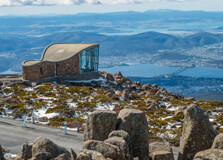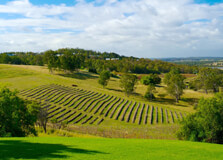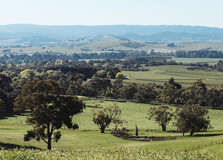
- ��Ӱֱ��
- Travel Packages
- Top Destination
-
Travel Attraction
By Category
Top Attraction

- Travel Agents
- Car Rentals
- Hotels

Mount Wellington, officially known by its Aboriginal name Kunanyi / Mount Wellington, is a towering natural landmark located just west of Hobart, the capital city of Tasmania, Australia. Rising to a height of 1,271 meters (4,170 feet), the mountain is an essential part of Hobart’s skyline and plays a central role in the city's natural and cultural identity. Covered in lush forests, alpine vegetation, and often dusted with snow during the winter, it offers breathtaking panoramic views of Hobart, the Derwent River, and beyond. How to Reach Mount Wellington, Hobart Reaching Mount Wellington is relatively simple, especially since it lies just 21 kilometers (13 miles) from the center of Hobart. The most common ways to get there are: By Car: Drive up Pinnacle Road, which takes you all the way to the summit. The road is well-maintained but can be closed in extreme weather. By Shuttle or Tour: Many local tour companies operate shuttles and guided tours from Hobart to the summit. By Bike: For the adventurous, cycling up Mount Wellington is a popular challenge. On Foot: There are several walking tracks leading up the mountain, with the Organ Pipes Track and the Pinnacle Track being two of the most scenic routes. Weather on Mount Wellington, Hobart The weather on Mount Wellington is unpredictable and significantly cooler than in Hobart city. Temperatures at the summit are often 10°C (18°F) lower than those at sea level. Snow can fall during the winter months, and strong winds are common year-round. Even in summer, visitors are advised to bring warm clothing. The summit often sits above the clouds, offering otherworldly views, but it can also be foggy and misty, reducing visibility. Timings and Opening Hours Mount Wellington is open to visitors year-round and there is no entry fee. Pinnacle Road is open daily but may be closed temporarily during hazardous weather, particularly in winter. It's advisable to check the local council or tourism websites for live road conditions and updates before heading up. Why is Mount Wellington Famous? Mount Wellington is famous for its dramatic scenery, natural diversity, and cultural significance. The mountain offers sweeping views of Hobart and southern Tasmania, making it a favorite for photographers, hikers, and nature lovers. It's also notable for its geological features like the towering Organ Pipes – striking dolerite columns formed by volcanic activity millions of years ago. The summit's unique alpine ecosystem supports various native plant and animal species. Its Aboriginal name, Kunanyi, acknowledges the mountain's cultural significance to the Palawa people, Tasmania’s Indigenous population. Entry and Visit Details about Mount Wellington, Hobart There is no entrance fee to visit Mount Wellington. Visitors can drive up to the summit via Pinnacle Road, park at the designated areas, and explore on foot. The summit features observation shelters and boardwalks that make it accessible for most visitors. Public toilets and picnic areas are available near the top and along the trails. It is recommended to visit early in the morning or late afternoon to catch the sunrise or sunset for the best photographic opportunities. However, be aware that weather can change quickly, and conditions at the summit can shift within minutes. History and Architecture of Mount Wellington Mount Wellington has long held cultural and spiritual significance for Tasmania's Aboriginal people. European explorers first documented the mountain in the early 1800s, and it was named in honor of the Duke of Wellington after his victory at the Battle of Waterloo. In the colonial era, it provided fresh water and timber for the growing settlement of Hobart. The mountain’s summit features minimal man-made structures to preserve its natural state, but it does have several shelters and lookout platforms that are designed to blend into the alpine environment. The Organ Pipes, a prominent rock formation, is one of the most iconic features and a natural architectural wonder. Things to Do at Mount Wellington, Hobart Enjoy Panoramic Views: The summit offers incredible views of Hobart, the Derwent River, and even Bruny Island on clear days. Hiking: There are numerous trails for all skill levels. Popular options include the Zig Zag Track, Lenah Valley Track, and Sphinx Rock walk. Rock Climbing: The Organ Pipes are popular among experienced climbers. Cycling: Thrill-seekers can mountain bike down well-marked tracks. Photography: The varied terrain, wildlife, and stunning vistas make it a photographer’s paradise. Snow Play: In winter, snow covers the summit, attracting visitors for snowball fights and scenic walks. Interesting Facts about Mount Wellington, Hobart Mount Wellington was first climbed by European settlers in 1798. The mountain’s Aboriginal name “Kunanyi” means “the mountain” in the local Palawa language. It forms part of the Wellington Park Reserve, which covers over 18,000 hectares. Despite its height, it can snow at the summit even in summer months due to altitude. It’s home to diverse flora and fauna, including wallabies, echidnas, and over 500 species of native plants. Tips for Visiting Mount Wellington, Hobart Check Weather Forecast: Conditions can change rapidly, so always check before heading out. Dress in Layers: Bring warm and waterproof clothing even in summer. Bring Snacks and Water: There are limited facilities at the summit, so carry essentials. Start Early: Morning visits offer the best visibility and fewer crowds. Respect Wildlife and Nature: Do not feed animals or pick plants. Drive Carefully: Pinnacle Road is steep and winding – use caution, especially in wet or icy conditions.
Explore More
Hunter Valley is one of Australia's premier wine regions located just north of Newcastle, New South Wales. Famous for its sprawling vineyards, boutique wineries, gourmet food experiences, and stunning countryside, Hunter Valley offers a perfect getaway for wine lovers and nature enthusiasts alike. Though it is a distinct region separate from Newcastle city, it is often associated with Newcastle due to its close proximity and easy accessibility from the city. How to Reach Hunter Valley, Newcastle Hunter Valley is approximately 1 to 1.5 hours' drive from Newcastle city center, making it very convenient for day trips or weekend escapes. By Car: The most popular way to reach Hunter Valley from Newcastle is by car. Take the M15 Motorway (Hunter Expressway) or the New England Highway north towards Cessnock, which is the heart of the Hunter Valley wine region. By Bus or Tour: Various tour operators in Newcastle offer guided day tours to Hunter Valley, including winery visits, wine tastings, and gourmet lunch experiences. Public buses run to nearby towns but are less frequent. By Train: While there is no direct train to vineyards, you can take a train from Newcastle to Cessnock or Maitland and then use local transport or tours to access wineries. Weather in Hunter Valley The Hunter Valley enjoys a temperate climate with hot summers and mild winters, ideal for grape growing. Summer temperatures typically range from 25-35°C (77-95°F), while winters are cooler, averaging 8-18°C (46-64°F). Spring and autumn are particularly pleasant times to visit, with mild weather, fewer crowds, and picturesque landscapes featuring blossoming vineyards and harvest activity. Timing for Visiting Hunter Valley Hunter Valley is open to visitors year-round. The peak tourism season runs from late spring through autumn, coinciding with warmer weather and various festivals, including wine and food events. Most wineries and attractions operate between 10:00 AM and 5:00 PM daily, though hours may vary. Booking in advance is recommended for wine tastings, dining, and tours during busy periods. Why Hunter Valley is Famous for Newcastle Hunter Valley’s fame largely comes from being Australia’s oldest wine-producing region, with a heritage dating back to the early 19th century. Its proximity to Newcastle makes it a favorite destination for locals and tourists based in the city who want to experience quality wines and gourmet food in a scenic setting. The region is well known for producing world-class Semillon and Shiraz wines, and it hosts numerous wine festivals, markets, and events, making it a vibrant cultural hub in the Newcastle region. Entry and Visit Details about Hunter Valley, Newcastle Entry to the Hunter Valley region and its vineyards is generally free, though wine tastings and special events usually incur a fee. Many wineries welcome visitors without appointments, but booking ahead is advisable, especially on weekends and holidays. Popular cellar doors and restaurants offer tastings, tours, and gourmet dining experiences. Visitors can also explore local art galleries, gardens, and markets throughout the region. History and Architecture of Hunter Valley The Hunter Valley was first settled by Europeans in the early 1800s, and vineyards were planted soon after by early colonists. It is Australia’s oldest wine region, with winemaking traditions evolving over more than 200 years. Architecturally, the Hunter Valley showcases a blend of historic colonial homesteads, rustic wineries, and modern cellar door facilities. Many vineyards operate from beautifully restored heritage buildings that add to the charm and character of the region. Things to Do in Hunter Valley, Newcastle Wine Tasting: Visit world-renowned wineries to sample a variety of wines including Semillon, Shiraz, Chardonnay, and more. Gourmet Dining: Enjoy fine dining experiences with locally sourced produce paired with regional wines at cellar door restaurants. Hot Air Ballooning: Experience breathtaking views of the vineyards and countryside with a sunrise balloon ride. Visit Markets: Explore local farmers' markets offering fresh produce, artisan foods, and crafts. Gardens and Parks: Wander through the Hunter Valley Gardens, a beautifully landscaped attraction featuring themed gardens. Golf and Spa: Relax at luxury resorts offering spa treatments and golf courses set among vineyards. Facts about Hunter Valley, Newcastle Hunter Valley is Australia’s oldest wine region, with winemaking dating back to the 1820s. The region produces more than 150 wineries, from small boutique producers to large estates. Hunter Valley’s Semillon is internationally recognized for its unique taste and aging potential. Annual wine and food festivals attract thousands of visitors, including the Hunter Valley Wine & Food Festival and Cellar Door Month. The region covers more than 6,000 hectares of vineyards. Tips for Visiting Hunter Valley, Newcastle Book winery tours and tastings in advance, especially during weekends and festival periods. Consider hiring a driver or joining a guided tour to enjoy wine tasting safely. Visit during spring or autumn for mild weather, fewer crowds, and beautiful vineyard scenery. Wear comfortable shoes and dress in layers as weather can change during the day. Take time to explore not just wineries but also local markets, gardens, and artisan shops. Bring a camera to capture the stunning countryside and vineyard landscapes.
Explore More
The Yarra Valley is one of the most picturesque and celebrated wine regions in Australia. Located just an hour’s drive from Melbourne, it is known for its stunning landscapes, world-class wineries, and a relaxed, country atmosphere. This popular destination has become a must-visit for both locals and tourists. Whether you're a wine enthusiast, nature lover, or history buff, Yarra Valley offers something for everyone. How to Reach Yarra Valley, Victoria, Australia Yarra Valley is easily accessible from Melbourne, which is the capital city of Victoria. Visitors can reach the valley by car, public transport, or organized tours. By Car: The most convenient way to reach Yarra Valley is by car. From Melbourne, it takes approximately one hour to drive to the region. The drive is scenic and easy, along well-maintained highways. By Train: If you prefer public transport, you can take a train from Melbourne's Flinders Street Station to Lilydale Station, which is the gateway to Yarra Valley. From Lilydale, you can catch a bus or take a short taxi ride to the vineyards and attractions of the region. By Tours: Many tour operators offer day trips from Melbourne to Yarra Valley. These tours often include guided visits to vineyards, gourmet food experiences, and stops at other local attractions. Weather in Yarra Valley, Victoria, Australia The Yarra Valley experiences a temperate climate, making it a year-round destination. Summers are generally warm and dry, with temperatures ranging from 25°C to 35°C (77°F to 95°F). Winters are cooler, with temperatures between 3°C to 15°C (37°F to 59°F). Rain is fairly evenly spread throughout the year, but the region sees more rainfall during the winter months. The best time to visit depends on the activities you are interested in. For wine lovers, the harvest season in late summer to early autumn (February to April) is ideal. The weather is perfect for outdoor activities such as wine tasting and hot air balloon rides. However, the valley’s charm extends year-round, and each season has its own unique beauty. Why Yarra Valley is Famous Yarra Valley is world-renowned for its premium wine production. It is one of the oldest wine regions in Australia and is famous for its cool climate, which produces high-quality Pinot Noir, Chardonnay, and sparkling wines. The region is also known for its lush landscapes, including rolling hills, forests, and rivers, making it a great place for photography and outdoor activities. In addition to wine, Yarra Valley is famous for its vibrant food scene, with a range of gourmet restaurants, farmers' markets, and artisanal food producers. Visitors can enjoy fresh, local produce, cheese, chocolate, and more. Entry and Visit Details about Yarra Valley, Victoria, Australia Yarra Valley is open to the public year-round, and there is no formal entry fee to the region itself. However, many of the individual wineries, attractions, and tour experiences may have an entry fee or charge for participation. For example, wine tastings typically cost between $5 and $20, depending on the vineyard, with some wineries offering free tastings or discounts for purchases. There are numerous accommodation options, ranging from luxury hotels and boutique lodges to bed and breakfasts and campgrounds. Visitors can also explore the region's attractions by booking guided tours or taking part in local events and festivals. History and Architecture of Yarra Valley, Victoria, Australia The history of Yarra Valley dates back to the early 19th century, when European settlers first arrived in the area. The valley was originally home to the Wurundjeri people, the traditional custodians of the land. The first vineyards in the region were planted in the 1830s, and it quickly became a center for agriculture and wine production. Architecturally, Yarra Valley showcases a mix of colonial-era buildings, modern wineries, and charming rural cottages. The region’s wineries often feature stunning vineyard views, contemporary designs, and beautifully restored historical buildings. Many of these wineries offer visitors a chance to learn about the history of the region, as well as the wine-making process. Things to Do in Yarra Valley, Victoria, Australia Yarra Valley is a diverse destination with a variety of activities to suit all interests: Wine Tasting: Visit the many wineries and cellar doors in the region. Enjoy a wine tasting experience while learning about the different varieties produced in Yarra Valley. Hot Air Ballooning: For a truly unique experience, take a hot air balloon ride over the valley. The aerial views of the vineyards and surrounding landscape are breathtaking, especially at sunrise. Hiking and Nature Walks: Yarra Valley is home to a number of beautiful national parks and trails. Popular spots for hiking include the Yarra Ranges National Park and the Warburton Rail Trail. Visit Local Markets: Explore the region's farmers’ markets, which are held on weekends. These markets offer local produce, handmade goods, and gourmet food. Gourmet Dining: Yarra Valley is known for its excellent restaurants that serve fresh, local ingredients. Many of the wineries also have restaurants that pair meals with their wines. Facts About Yarra Valley, Victoria, Australia Yarra Valley is home to over 80 wineries, producing world-class wine. The valley covers an area of approximately 4,000 square kilometers. The region is also known for its local produce, including cheese, chocolate, and gourmet foods. Yarra Valley has been producing wine since the 1830s, making it one of the oldest wine regions in Australia. The area is also popular for outdoor activities such as cycling, bushwalking, and wildlife watching. Tips for Visiting Yarra Valley, Victoria, Australia Plan Ahead: Yarra Valley is a popular destination, so it’s best to book accommodation and winery tours in advance, especially during peak seasons like harvest time in autumn. Designated Drivers: If you plan to visit multiple wineries, consider hiring a driver or booking a tour. This will allow you to enjoy wine tastings without worrying about driving. Respect Local Customs: Many of the wineries are family-owned, and respecting their traditions and the local environment is important. Always be mindful of your behavior and noise levels. Pack for the Weather: Weather in the valley can change quickly, so bring layers and be prepared for varying conditions, especially if you're planning on hiking or outdoor activities. Stay Hydrated: Whether you're wine tasting or hiking, always carry water with you to stay hydrated.
Explore More